The Different Types of Carabiners for Climbing (2024 Guide)

Published on: 06/14/2023
From the outsider’s perspective, all climbing carabiners look the same. They open and close, hold items, or attach one thing to the next. However, to the climber, all carabiners are very different.
Carabiners are as diverse and specialized for climbers as the baits and lures fishermen employ. They come in different shapes, sizes, and colors, have special features, and excel in certain scenarios.
Keep reading to get the definitive download on all the different types of carabiners on the market and for some guidance on how to best apply specific carabiners to their intended scenarios.
Are you looking for specific model recommendations? Check out our selection of the best climbing carabiners of 2024.
What Is a Carabiner?
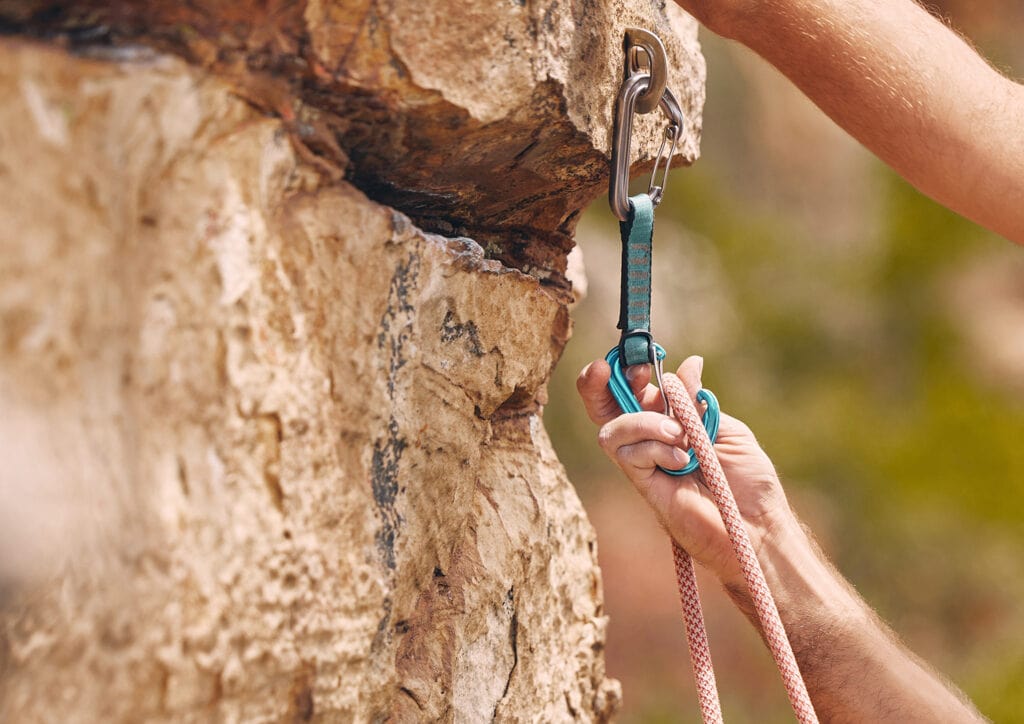
According to the Merriam-Webster dictionary (1), a carabiner is “a usually D-shaped or oblong metal ring with one spring-hinged side that is used especially in mountain climbing as a connector and to hold a freely running rope.”
The Core Components of a Carabiner
Ironically, many climbers know how to operate carabiners without actually knowing what the different parts of the tool are called. Obviously, there are subtle differences and different features between carabiners.
However, every carabiner will at least contain the following five core components.
- Nose: the hook-shaped portion of the carabiner that latches with the gate.
- Gate and Rivet Pin: the mechanical part of the carabiner that snaps open and closed.
- Spine: the opposite side of the carabiner where the carabiner’s strength ratings are depicted.
- Basket: the carabiner’s larger, more rounded side on the same end as the nose.
- Crotch: the smaller side of the carabiner on the same end as the rivet pin.

Most modern carabiners used in climbing are made with aluminum alloy metals (2). That’s because aluminum nicely blends strength and durability without becoming too heavy.
However, some carabiners are also made of steel. Steel carabiners are excellent because of their high wear resistance and tensile strength. But obviously, they are much heavier.
Generally speaking, carabiners have two types of gates: locking and non-locking.
Within the locking gate category, various locking mechanisms are designed for different applications. Similarly, in the non-locking category, different gates are ideal in different scenarios.
Let’s take a look at the specifics, starting with lockers.
Locking Carabiners (Lockers)
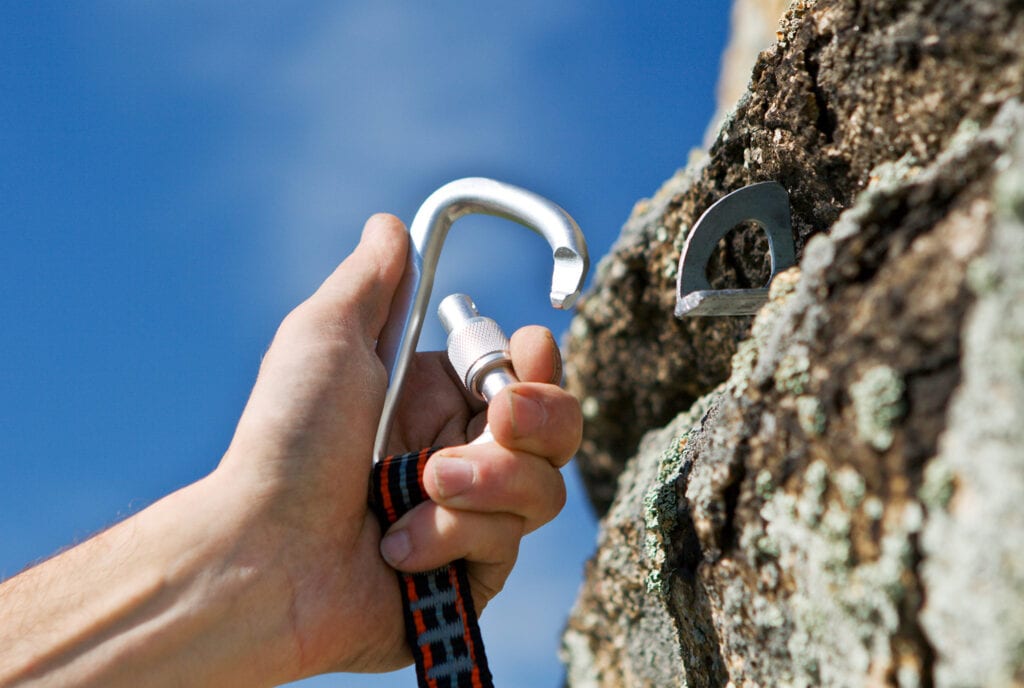
The first type of carabiner I want to talk about is locking carabiners or lockers.
Lockers are carabiners with an additional locking mechanism on the gate opening that can be locked to prevent the gate from opening.
Because of their additional locking mechanism, lockers are frequently used for critical linkages throughout the climbing system. For example, when attaching a belay device to your harness or constructing a masterpoint in an anchor.
Pros & Cons of Locking Carabiners
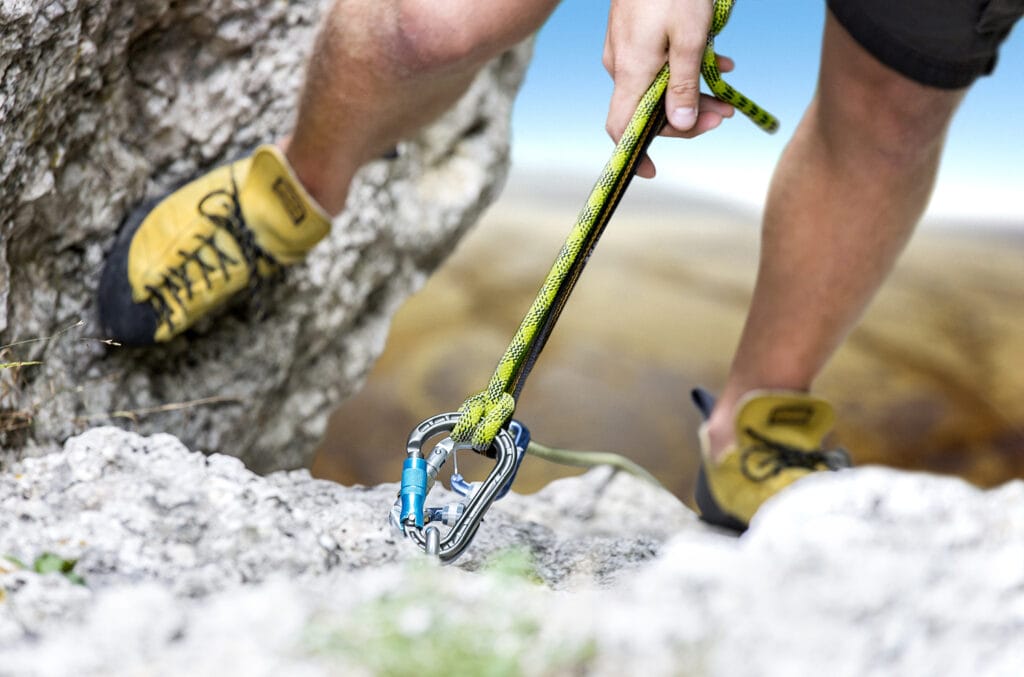
The major advantage of locking carabiners is the additional safety you get when you close and properly lock the gate.
However, even locked locking carabiners can be unlocked alone. This is most common when screw-gate lockers become unlocked due to vibration or rubbing. To prevent this, always clip and flip your screw gate lockers so the locking mechanism is pointed down.
Another con of locking carabiners is that they are heavier than most carabiners. That’s why I recommend only using lockers for specific critical linkages, like anchor points, and not for every other application.
Lock Types on Locking Carabiners
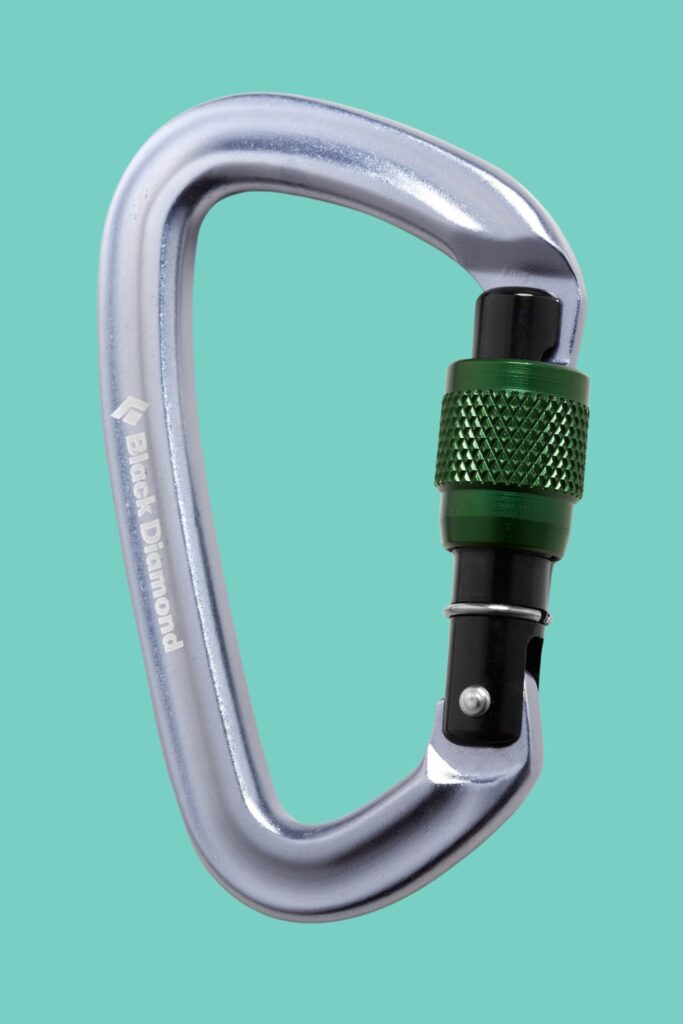
Lockers come with various locking mechanisms.
Screw-Lock Carabiners
Screw-lock carabiners have a manual locking mechanism and threaded sleeve that you have to screw shut once the carabiner has snapped shut into its closed position.
Screw-locking carabiners are one of the most common and versatile types of lockers, for example, the Black Diamond Positron Screwgate (3). Manual-locking carabiners are ideal for linkages where you want extra security and the flexibility to open and close the carabiner quickly, like when working with munter and clove hitches.
Double Action Carabiners
Double or dual-action carabiners are lockers that require you to perform two actions to unlock them. In addition, after releasing the gate, double-action lockers will lock automatically.
For example, twist-lock carabiners require you to twist the sleeve on the gate and then push it open. Dual-action carabiners, like the Petzl Am’d Twistlock Carabiner (4), are ideal for attaching belay devices where you want them to lock automatically.
Triple Action Carabiners
Triple auto-locking carabiners require three actions to open the gate. For example, the Petzl William “Triact” Carabiner (5) requires you to depress a small button, twist and then pull up on the sleeve to unlock it.
Triple-action carabiners are ideal for critical linkages where additional security is your utmost priority, like two opposite and opposed lockers in a top rope masterpoint.
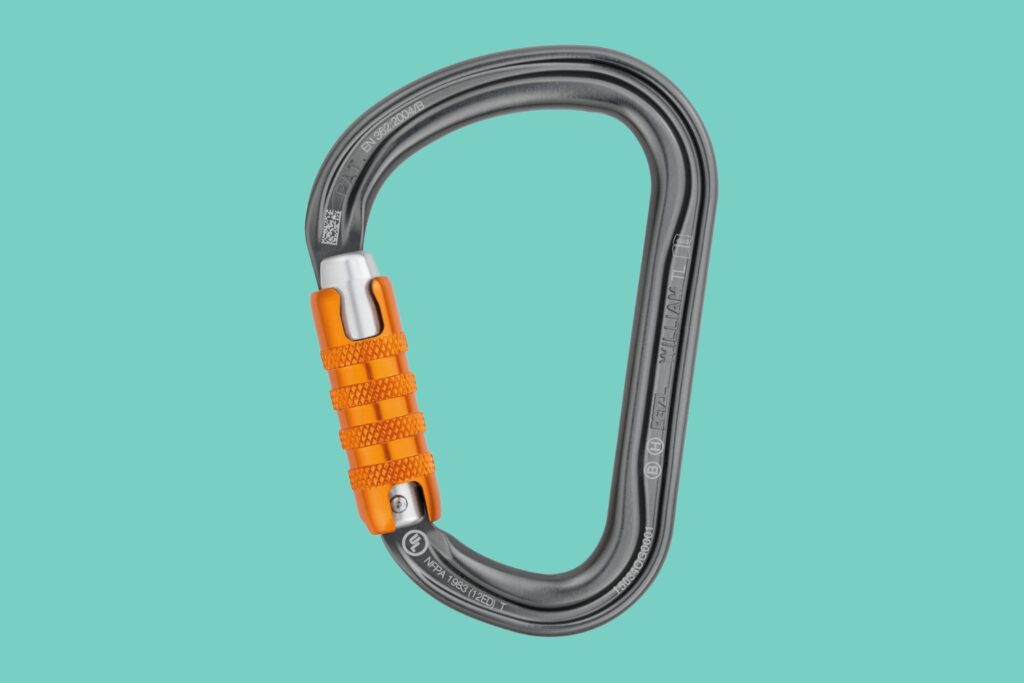
Non-Locking Carabiners (Non-Lockers)
The second type is non-locking carabiners or non-lockers. These do not have an additional locking mechanism on the spring-loaded gate. They can be easily opened without any extra actions.
Of all the carabiners on a climber’s harness, non-lockers are the most common. Non-locking carabiners are used in non-critical linkages in your climbing system.
For example, the legs of your trad anchor, the quickdraws on a sport route, and racking gear.
Pros & Cons of Non-Locking Carabiners
Non-lockers’ advantage is their simplicity, ease of use, and weight. There’s nothing much more straightforward in climbing than pressing open the gate of a non-locker and letting it snap shut.
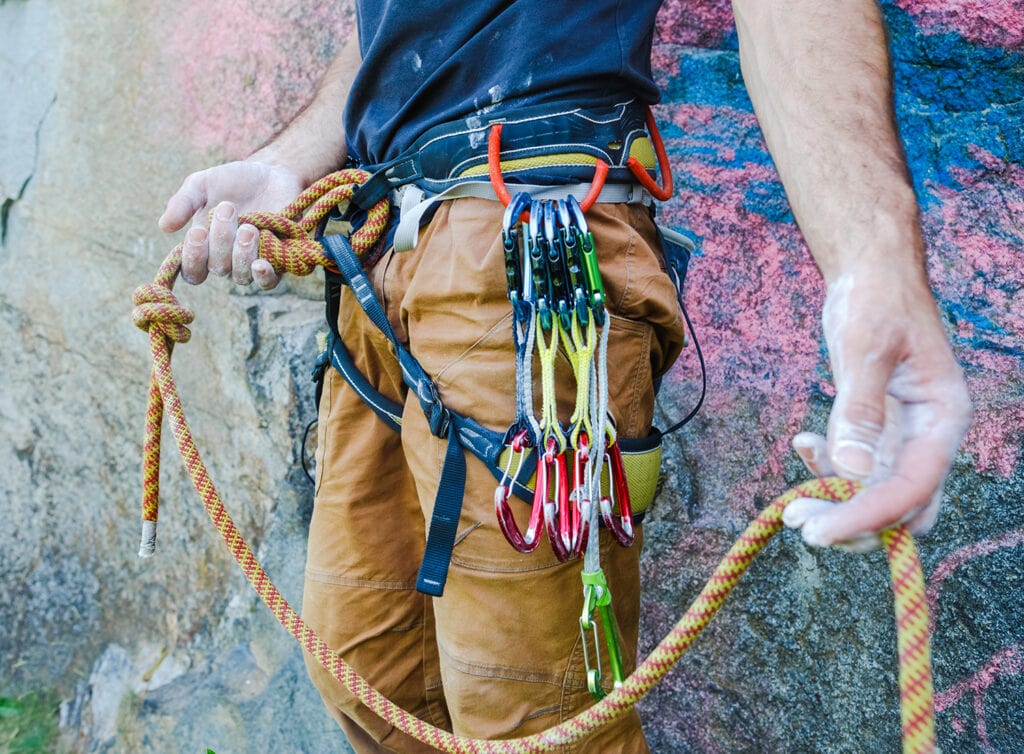
However, the major drawback of carabiners without locking gates is that they can become accidentally opened. This is most common when the carabiner is positioned so another object can press the gate open, like the rock or an anchor component.
However, the percentage chance of this occurring to you is small, especially if you mitigate the scenarios in which the non-lockers you use have the risk of opening accidentally.
For example, in my decade of climbing experience, I’ve only had one non-locker accidentally open. My partner and I were hanging on a two-bolt anchor where I installed a quad with two non-lockers on each leg. During our transition from one pitch to the next, the carabiner on one leg was pressed open and unclipped. Luckily, we were tethered correctly into the quad I built, and the second bolt we shock-loaded was bomber.
Gate Types on Non-Locking Carabiners
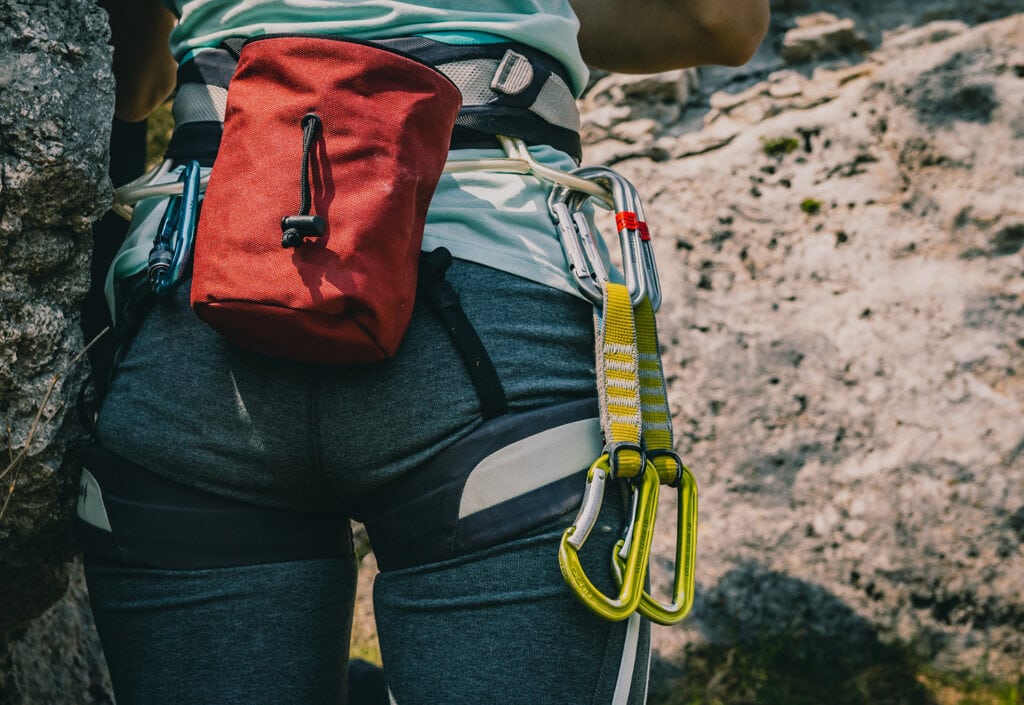
Non-lockers come with various types of gates (6).
Bent Gate
Carabiners with bent gates feel the most ergonomic in your hand. Therefore, bent gates are the easiest and fastest to clip. That’s why bent gate carabiners are commonly utilized in the rope end of a quickdraw for sport climbing or the rope end of alpine draws in trad climbing.
Straight
Straight gate carabiners are the most classic and reliable. They behave the most predictably and are safer when clipping bolts. Therefore, straight gate carabiners are common used for the bolt end of quickdraws and alpine draws.
Solid Gate
The solid gate design is the most classic in terms of types of gates on non-lockers. Solid gate carabiners are beefier than wire gates and last much longer. A solid gate carabiner is ideal for sport climbing and scenarios where a little extra weight is worth it to have more durability.
Wiregate
Wiregates are the most modern closure system for non-locking carabiners. Wiregates weigh less and are less prone to gate flutter. They also resist icing up more than solid gates.
Therefore, wire gate carabiners are commonly used when weight savings matter, for example, in trad or alpine climbing. Or, during winter climbing, where you will be dealing with snow and ice.
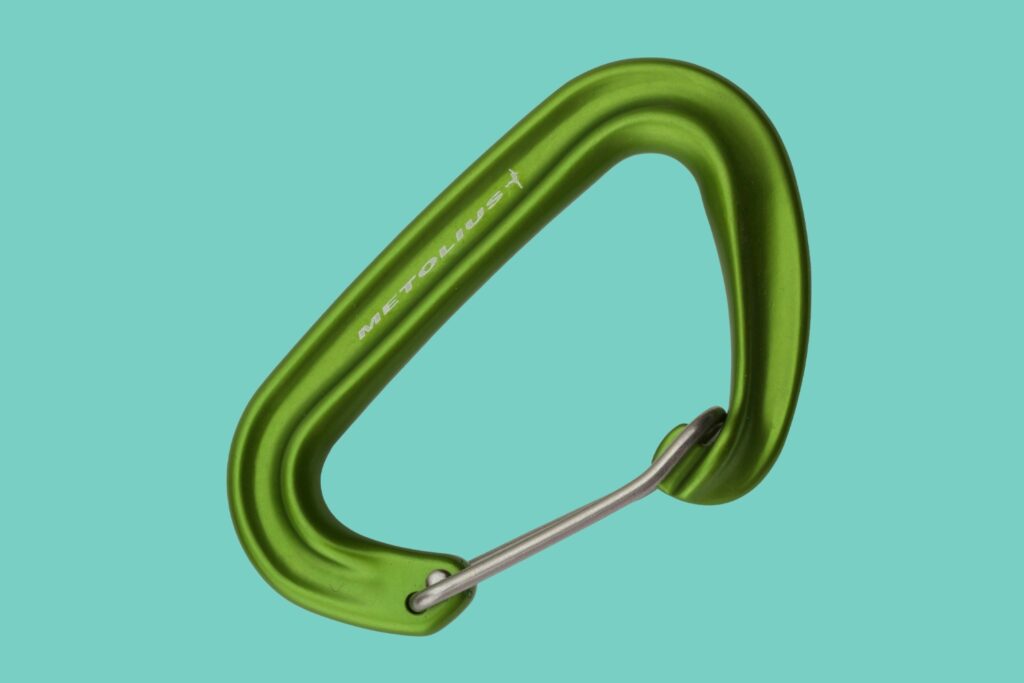
Shape
The shape of the carabiner is one of its most essential characteristics. Of all the other features a carabiner can possess, the shape most commonly dictates its intended usage.
Oval Carabiners
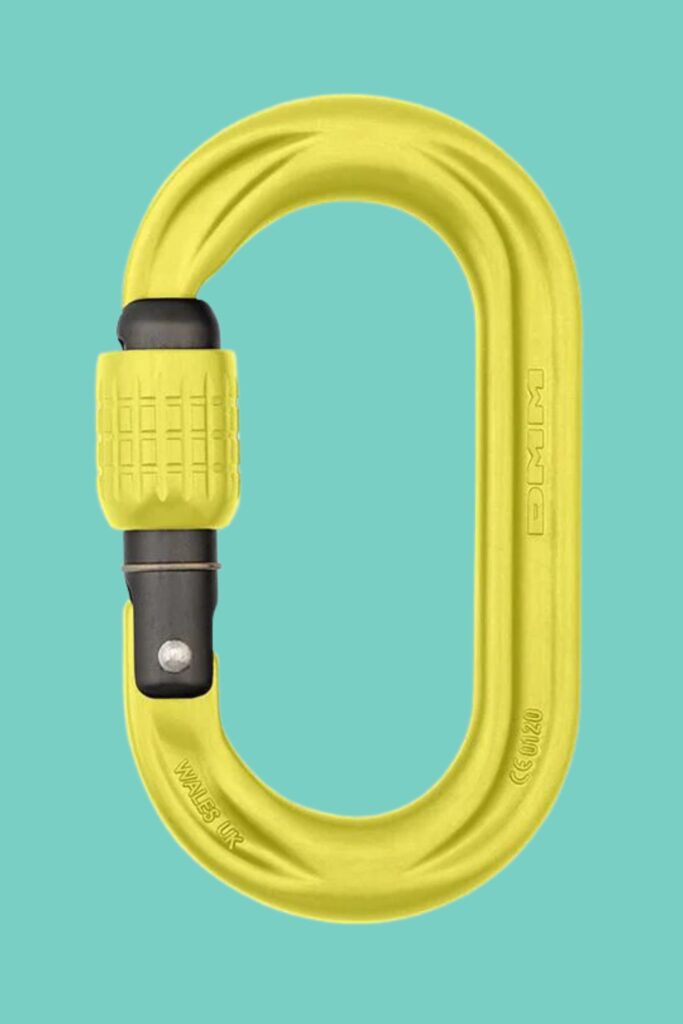
Oval carabiners are the original shape. However, nowadays, you don’t see too many out at the cliff. Oval carabiners have a uniform basket and crotch. Ovals come in locking and non-locking designs.
Pros & Cons: oval carabiners are super affordable. They are excellent for holding gear, like your rack of stoppers, and because of their symmetrical shape, they tend not to get cross-loaded. However, unfortunately, oval-shaped carabiners are not nearly as strong as other shapes.
Climbing Applications: oval carabiners are good for holding gear and hauling equipment. Ovals are also the go-to option for rescue carabiners because they help prevent cross-loading.
D-shaped Carabiners

Like ovals, traditional D-shape carabiners are outdated. However, their tried and true D-shape design makes them ideal for almost any application.
- Pros & Cons: the symmetrical D-shape is one of the strongest shapes.
- Climbing Applications: D-shape carabiners are ideal for non-critical linkages, racking gear, quickdraws, and alpine draws.
Asymmetric D-Shape Carabiners
Asymmetrical D-shaped carabiners, also known as offset D carabiners, are one of the most popular designs. They get their name because the D-shape they exhibit is slightly larger on the basket end of the carabiner compared to the crotch of the carabiner.
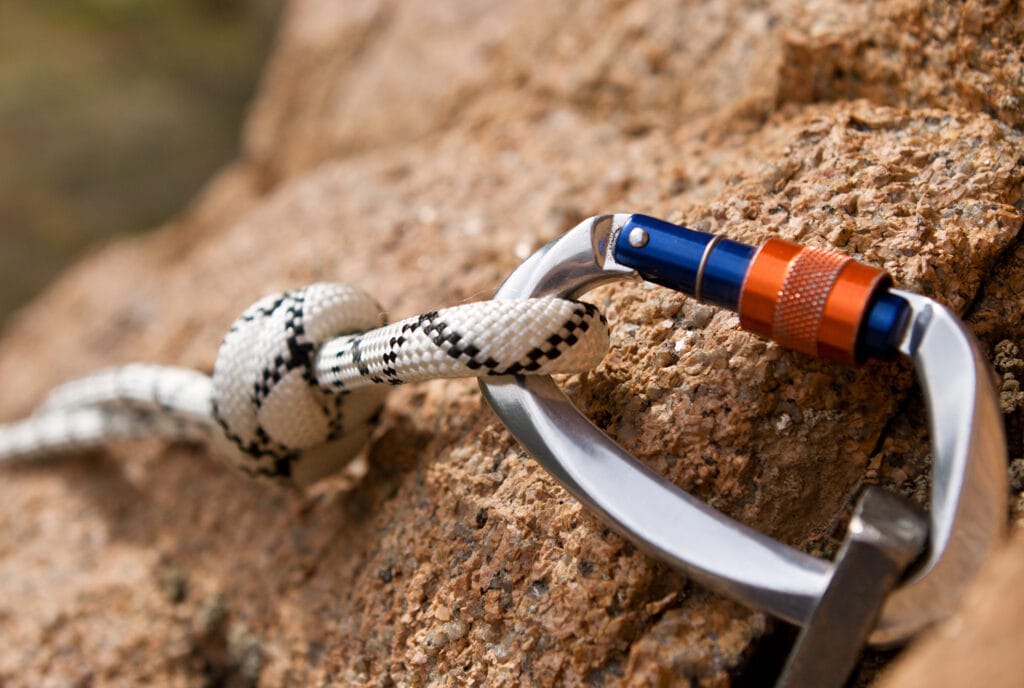
- Pros & Cons: asymmetric D-shaped carabiners have a large gate opening for easy clipping. They are strong and super lightweight. However, they are less strong than traditional D-shaped carabiners and tend to be more expensive.
- Climbing Applications: Locking asymmetrical D-shaped carabiners can be used for critical linkages in an anchor, friction hitch backups, and your GriGri. Non-locking asymmetrical D-shaped carabiners are suitable for racking gear and alpine draws.
HMS “Pear-Shaped” Carabiners
HMS locking carabiners, also known as pear-shaped carabiners, are the workhorses of the climbing world. They are highly versatile and utilized in a number of critical scenarios, like belaying, building anchors, and rappelling.
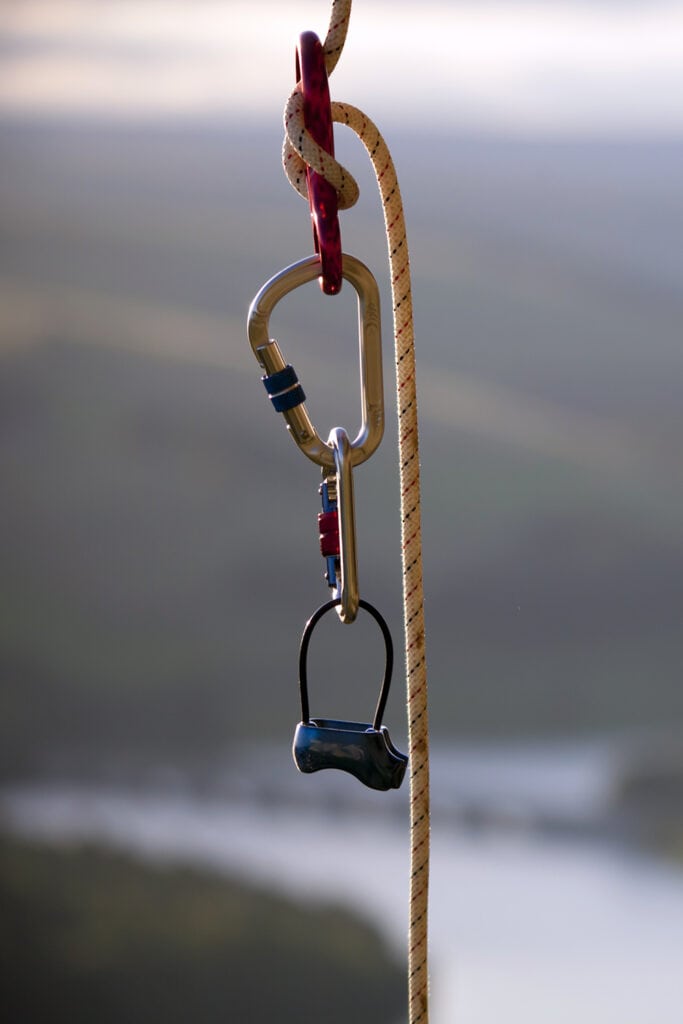
HMS stands for the German word halbmastwurfsicherung, which roughly translates to “half clove hitch belay,” also known as a munter hitch. That’s because an HMS carabiner has a large basket, perfect for a munter hitch or tethering with a clove hitch.
- Pros & Cons: an HMS carabiner is super strong and has a larger gate opening.
- Applications: HMS carabiners are perfect for trad anchor masterpoints and top rope masterpoints.
Strength and Ratings
Not all carabiners are strong enough to be used in rock climbing. To ensure that the carabiners you are using are strong enough, ensure that it is certified by the Conformité Européenne (CE) (7) and International Climbing and Mountaineering Federation (UIAA) (8).
The CE and UIAA certifications are laser etched or forged onto the spine of the carabiner. These numbers and symbols refer to the strength of the carabiner in three orientations.

- The first symbol and subsequent number refer to the carabiner’s strength when closed and loaded along its major axis. The major axis of the carabiner runs parallel to the spine and is the carabiner’s strongest orientation.
- The second symbol and number rating refer to the carabiner’s strength along the minor axis.
The minor axis runs perpendicular to the spine of the carabiner. Carabiners are not designed to be loaded across the minor axis, also known as cross-loading, but they still can withstand some force. - The third symbol and number rating refer to the carabiner’s strength when the gate is left open or ajar (gate open strength). Of the three orientations, a carabiner is at its weakest when the gate is left open.
Minimum Breaking Strength of UIAA Certified Carabiners
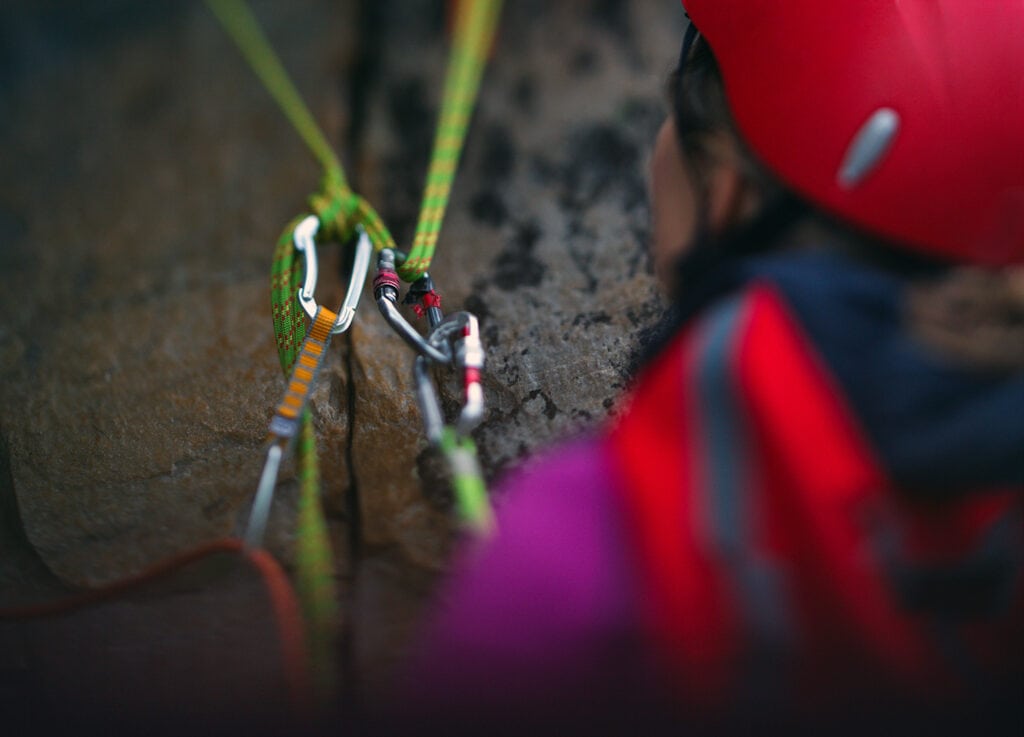
Carabiners certified by the CE or UIAA are robust – they will not break when used as intended in a rock climbing scenario. However, if cross loaded, left open, or fallen on in a strange orientation, carabiners are significantly weaker and have been known to break.
Fortunately, carabiners can withstand extreme amounts of force. The measurement of force used for carabiners is kilonewtons (kN) (9). One kilonewton of force roughly equals 224 pounds (lbs)/102 kg.
Most carabiners have a strength of 18-25 kN (4,046-5,620 lbs) along their major axis, and 6 to 8 kN (1,348-1,798 lbs) along the minor axis.
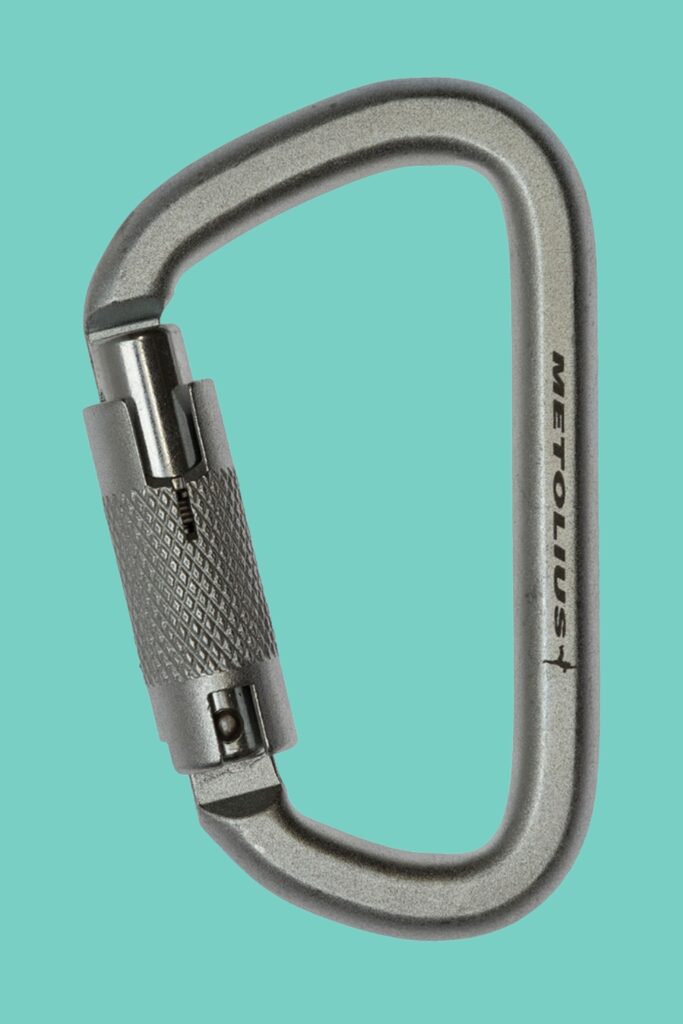
To ensure that carabiners are adequately strong for normal rock climbing usage, the UIAA has minimum breaking strength for each style of carabiner.
- Major Axis: 20 kN for all carabiner shapes except ovals. 18kN for ovals.
- Open Gate: 7kN for D and Offset D carabiners, 6kN for HMS, and 5 kN for ovals.
- Minor Axis: 7 kN for all carabiner shapes
Size and Weight
Carabiners come in a multitude of shapes and weights. The larger the carabiner is, the more it will weigh.
In addition, carabiners with more features will weigh more than those without, like a simple wiregate. And lastly, the material the carabiner is made with will impact its weight also.
For example, the Camp Nano 22 (10) is one of the lightest carabiners on the market. Thanks to its small size, aluminum construction, and wire gate, the Nano weighs roughly 22 grams.

On the other side of the spectrum, the Metolious Steel Locking Carabiner (11) weighs 221 grams because of its larger size, steel construction, and locking mechanism.
Besides these two extreme examples, you will most likely encounter carabiners that weigh between 30 and 100 grams.
Another thing to consider is the size of the gate opening. A large carabiner will have a larger gate opening than a smaller carabiner. This can impact comfort and ergonomics when performing techniques and manoeuvres.
Picking the Right Carabiner
As you’ve probably learned from this article, there are many types of carabiners. For the most part, carabiners are versatile tools that you can apply in various scenarios.
However, there are instances when you are better off using one carabiner over another.
Below I will share some of my personal preferences regarding the carabiners I like to use for specific applications.
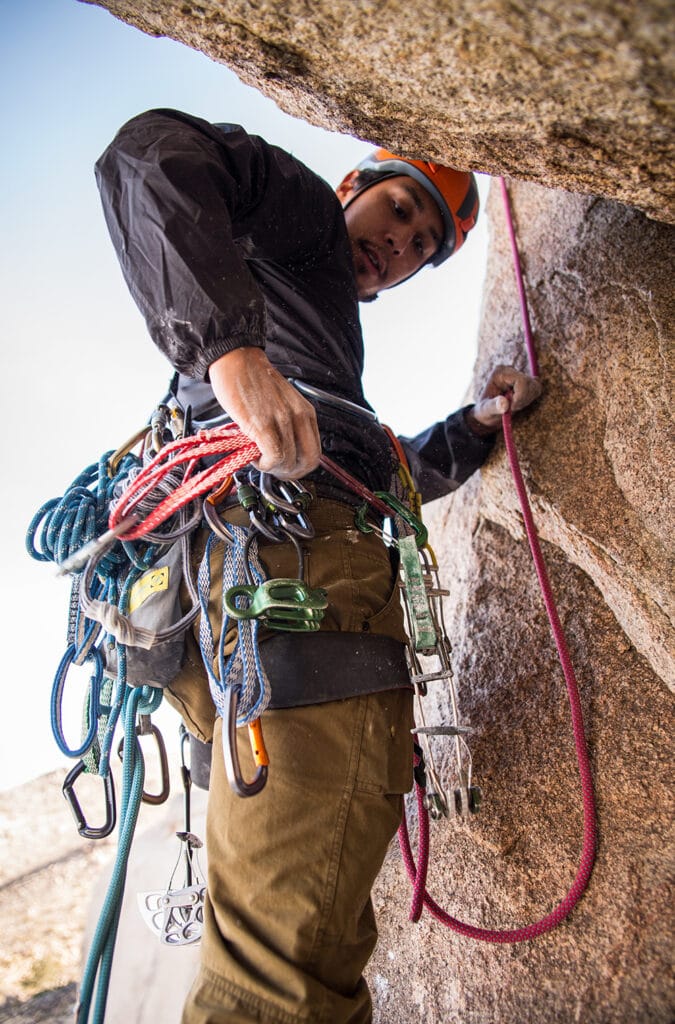
- Sport Climbing: I prefer quickdraws with solid gates. The rope end carabiner is bent while the bolt end is straight. I also like to use a locking quickdraw consisting of a mini D-shaped locking carabiner for the bolt and a large HMS locker for the rope end for building anchors on bolts.
- Trad Climbing: I carry three or four screw-gate locking pear-shaped carabiners for the masterpoints of my anchors, clove hitches, and belaying with a munter hitch.
- Belaying: When lead belaying with a Gri Gri, I prefer using a mini auto-lock carabiner. When I am belaying my partners from above, I use a mini D-shaped screwgate carabiner to position my belay device in guide mode and a round stock pear-shaped carabiner in the belay device.
- Rappelling: For the carabiner that links my extended rappel device to my tether, I like using a round stock, screwgate carabiner. For my friction hitch backup, I use a miniature D-shaped locking carabiner.
- Racking and Organizing Gear: My racking carabiners are miniature, lightweight carabiners with a wiregate. I also carry two or three additional non-locking wiregates for different uses, like hanging my backpack from the anchor while guiding clients.

Final Thoughts
Long story short, carabiners designed for climbing and certified by the CE and UIAA are incredibly bomber. When applied correctly, carabiners rarely break and fail. However, that’s not to say that breaking a carabiner will never happen to you.
To avoid this, always make sure you are using your carabiners correctly.
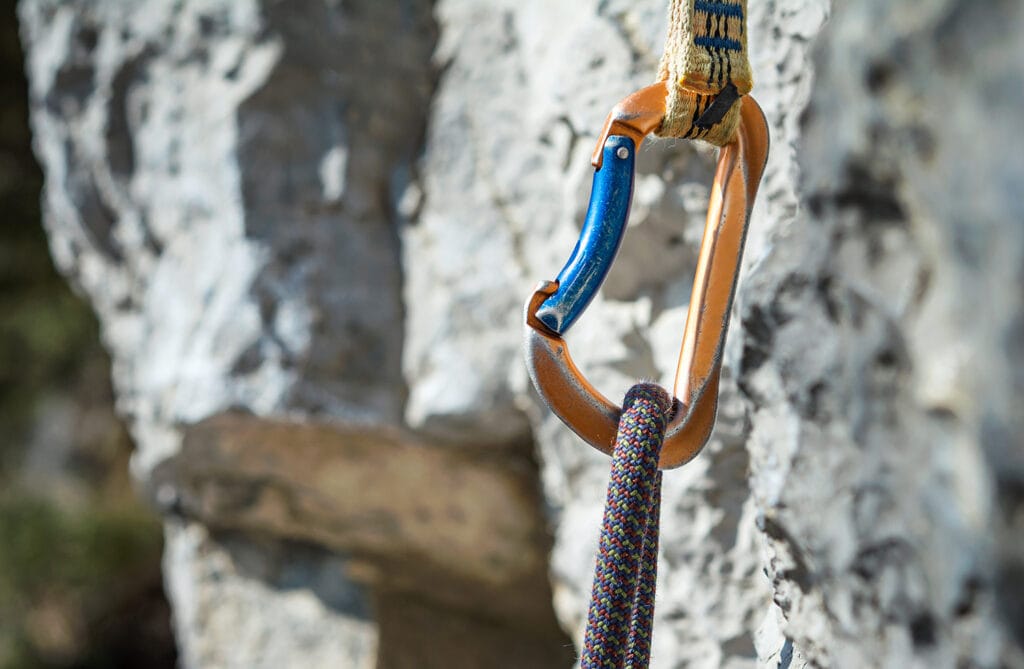
In figuring out what carabiners you like for certain applications, take some time to experiment. Carabiner shapes and styles somewhat dictate how they should be used, but ultimately it’s up to you.
Then, way down the line, when you’ve scraped off all the color anodization and a groove is forming in the basket from repetitive belaying and rappelling, you can read our next article about knowing when to retire your carabiners.
I hope you found this article helpful. Be safe out there, and remember your double checks.
References
Carabiner Definition & Meaning
Merriam-Webster dictionary (retrieved on 06/12/2023)
https://www.merriam-webster.com/dictionary/carabiner
Structural Analysis of Carabiners Materials Used at Personal Protective Equipments
D. P. Burduhos Nergiş et al. (May 2018)
IOP Science
https://iopscience.iop.org/article/10.1088/1757-899X/374/1/012040
Black Diamond Positron Screwgate Carabiner
REI (retrieved on 06/12/2023)
https://www.rei.com/product/899070/black-diamond-positron-screwgate-locking-carabiner
Petzl Am’D Twistlock Carabiner
REI (retrieved on 06/12/2023)
https://www.rei.com/product/100206/petzl-amd-twistlock-carabiner
Petzl William “Triact” Carabiner
Backcountry (retrieved on 06/12/2023)
https://www.backcountry.com/petzl-william-locking-carabiner
Anatomy of a carabiner
DMM (retrieved on 06/12/2023)
https://dmmwales.com/knowledge/august-2012/anatomy-of-a-carabiner
CE marking
European Commission (retrieved on 06/12/2023)
https://single-market-economy.ec.europa.eu/single-market/ce-marking_en
Safety Standards
UIAA – International Climbing and Mountaineering Federation (retrieved on 06/12/2023)
https://theuiaa.org/safety/safety-standards/
Newton (unit)
Wikipedia (retrieved on 06/12/2023)
https://en.wikipedia.org/wiki/Newton_(unit)
Camp Nano 22 Carabiner
Backcountry (retrieved on 06/12/2023)
https://www.backcountry.com/camp-usa-nano-wire-carabiner
Metolious Steel Locker Carabiner
Backcountry (retrieved on 06/12/2023)
https://www.backcountry.com/metolius-screw-lock-auto-lock-steel-carabiners
